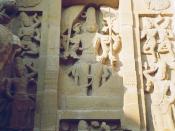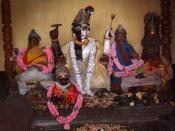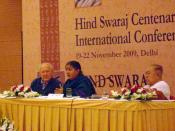It is a common place. We have seen it in temples, on calendars, on matchbox labels: the blue body smeared with ash, the third eye, the tiger-skin. Locked in the lotus posture he mediates in the mist and snow of Kailash; the moon rests on his hair and the Ganga spills from his tangled locks. Shiva is the ascetic whose meditation sustains the universe. He reposes at the centre and contemplates the world, concentrating its energies into himself. Or perhaps the movement is centrifugal: energy radiates from him and he does not so much consider the world as create it, all its immensity and richness being but thoughts in his mind.
As a yogi, Shiva is the master of his senses. His self-discipline grants him control over the world. How shall we reconcile Shiva's celibacy with the lewd forms he takes? For he is commonly worshipped as an 'erect phallus' or linga.
In the linga it is not Shiva's sexuality that is celebrated, but his potency. The linga, ever erect and never expended, is symbolic of the spiritual energies of the God, an eternally renewed promise. Procreation is also metaphor for all forms of creativity. Traditionally, Brahma is the Creator, Vishnu, the Preserver and Shiva, the Destroyer, but within the cult of each, the one God is believed to be omnipotent. While Vishnu has the power to destroy evil, Shiva, the destroyer can create. The linga then , is not a mere concentration of energy: the universe issued from it at the time of Creation. There are some lingas, meal or stone, with Shiva's image carven on them. They are called the lingodhava of arising out-of-the-linga images. Itt is as tthough some alchemy within linga has moulded a being that swells and presses outward, striving...


